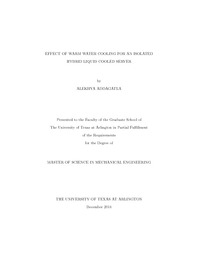
ATTENTION: The works hosted here are being migrated to a new repository that will consolidate resources, improve discoverability, and better show UTA's research impact on the global community. We will update authors as the migration progresses. Please see MavMatrix for more information.
Show simple item record
| dc.contributor.author | Addagatla, Alekhya | en_US |
| dc.date.accessioned | 2015-07-01T17:50:31Z | |
| dc.date.available | 2015-07-01T17:50:31Z | |
| dc.date.issued | 2014-12 | |
| dc.date.submitted | January 2014 | en_US |
| dc.identifier.other | DISS-12940 | en_US |
| dc.identifier.uri | http://hdl.handle.net/10106/24951 | |
| dc.description.abstract | Data center cooling strategies have changed overtime due to increases in power densities and ever increasing server cooling power requirement. Traditionally, most data centers adopt air cooling where the Computer Room Air Conditioning (CRAC) units pump volumes of chilled air to cool information technology (IT) equipment and dispose the heat from the servers to the ambient. With demand for energy-efficient and cost-effective data centers growing, alternative methods to both provide electrical power and cooling systems are the subject of active investigation. As data centers increase in size and current air-cooling systems reach their limitations, cooling technology will inevitably evolve towards air-liquid (hybrid) or liquid cooling systems. Server level indirect cooling is achieved through a combination of warm water and recirculated air (hybrid cooling) in a 2OU (OpenU) web server. The work presented highlights the impact of various inlet supply water temperatures within the ASHRAE TC 9.9 liquid cooling classes (W4) ranging from 27.5°C to 45°C in terms of server power consumption, component temperatures and cooling power consumption. | en_US |
| dc.description.sponsorship | Dereje, Agonafer | en_US |
| dc.language.iso | en | en_US |
| dc.publisher | Mechanical Engineering | en_US |
| dc.title | Effect Of Warm Water Cooling For An Isolated Hybrid Liquid Cooled Server | en_US |
| dc.type | M.S. | en_US |
| dc.contributor.committeeChair | Dereje, Agonafer | en_US |
| dc.degree.department | Mechanical Engineering | en_US |
| dc.degree.discipline | Mechanical Engineering | en_US |
| dc.degree.grantor | University of Texas at Arlington | en_US |
| dc.degree.level | masters | en_US |
| dc.degree.name | M.S. | en_US |
Files in this item
- Name:
- Addagatla_uta_2502M_12940.pdf
- Size:
- 1.916Mb
- Format:
- PDF
This item appears in the following Collection(s)
Show simple item record


